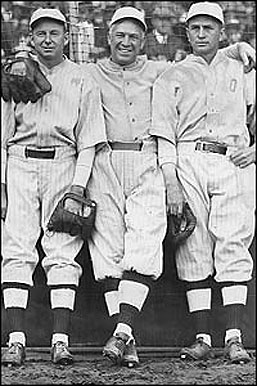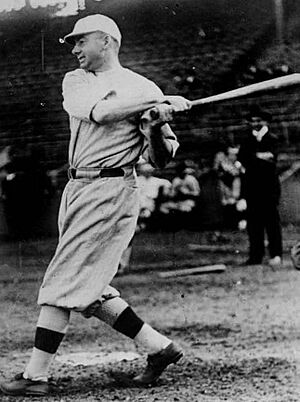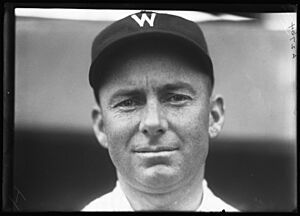Duffy Lewis facts for kids
Quick facts for kids Duffy Lewis |
|||
|---|---|---|---|
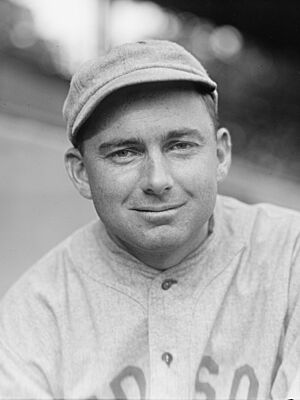
Lewis in 1915
|
|||
| Left fielder | |||
| Born: April 18, 1888 San Francisco, California, U.S. |
|||
| Died: June 17, 1979 (aged 91) Salem, New Hampshire, U.S. |
|||
|
|||
| debut | |||
| April 16, 1910, for the Boston Red Sox | |||
| Last appearance | |||
| June 6, 1921, for the Washington Senators | |||
| MLB statistics | |||
| Batting average | .284 | ||
| Home runs | 38 | ||
| Runs batted in | 791 | ||
| Teams | |||
|
|||
| Career highlights and awards | |||
|
|||
George Edward "Duffy" Lewis (born April 18, 1888 – died June 17, 1979) was an American professional baseball player. He was a left fielder in Major League Baseball (MLB). Duffy played for the Boston Red Sox, the New York Yankees, and the Washington Senators. His career lasted from 1910 to 1921.
Lewis went to Saint Mary's College of California. He started his MLB career with the Red Sox in 1910. There, he was part of the famous Golden Outfield with Tris Speaker and Harry Hooper. He helped the Red Sox win three World Series championships in 1912, 1915, and 1916. Later, he played for the Yankees and Senators. After his MLB career, he continued to play and manage in the minor leagues. He also worked as a coach and traveling secretary for the Boston Braves. Duffy Lewis is a member of the Boston Red Sox Hall of Fame.
Contents
Meet Duffy Lewis, Baseball Star!
Early Life and First Steps in Baseball
George Edward Lewis was born on April 18, 1888, in San Francisco, California. His mother's last name was Duffy, which is how he got his nickname. When he was seven, he was a mascot for a local baseball team. This shows he loved baseball from a young age!
Duffy went to Saint Mary's College of California. He started playing professional baseball in 1907. He played for teams like the Alameda Grays and the Oakland Oaks. In 1909, the Boston Red Sox noticed his talent and picked him to join their team.
Playing for the Boston Red Sox
Duffy Lewis became the Red Sox's main left fielder in 1910. He joined Harry Hooper and Tris Speaker to form the legendary Golden Outfield. This outfield was known for its amazing defense.
In his first year, Duffy hit for a .283 average. He also hit eight home runs, which was one of the best in the American League. In 1912, he had 109 runs batted in (RBIs), ranking second in the league. That year, the Red Sox won the American League championship. They then beat the New York Giants to win the 1912 World Series.
In 1914, something special happened. Babe Ruth played his first major league game. Duffy Lewis was the only player in history to pinch hit for Babe Ruth during a game!
World Series Champion!
Duffy Lewis was a key player in the Red Sox's success. In 1915, he hit .291. The Red Sox played the Philadelphia Phillies in the 1915 World Series. Boston won in five games. Duffy was amazing in this series, hitting .444. He also drove in five of Boston's 12 runs, helping them win Games 3 and 4. His great catches also helped the team win.
In 1916, the Red Sox won the American League championship again. They defeated the Brooklyn Robins in the 1916 World Series. Duffy hit .353 in that series. This made him a three-time World Series champion!
Duffy's Cliff: A Special Part of Fenway Park
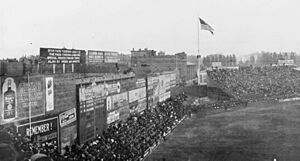
In 1912, the Red Sox moved into their new home, Fenway Park. This park had a unique feature in left field. There was a 10-foot high mound that sloped up to the 25-foot left field wall. Today, this wall is known as the Green Monster.
Duffy Lewis became a master at playing on this mound. He learned to catch balls while running up the slope and throw them while coming down. He was so good at it that the mound became known as "Duffy's Cliff"! People even drew cartoons of him climbing a mountain to make catches. The mound was removed in 1934 during park renovations.
Later Playing Career
Duffy Lewis did not play in 1918. He served in the United States Navy during World War I. He was a player-manager for the Navy's baseball team.
In 1919, the Red Sox traded Duffy to the New York Yankees. He played for the Yankees in 1919 and 1920. He then joined the Washington Senators in 1921. After playing 27 games for the Senators, he was released.
Even after leaving MLB, Duffy continued to play and manage. He played for the Salt Lake City Bees and led their league with a .403 batting average in 1921. He also managed several minor league teams until 1929.
Over his MLB career, Duffy Lewis was known as a great defensive left fielder. He led the American League in assists for left fielders four times. He also had a career batting average of .284 with 38 home runs and 793 RBIs. He was a "clutch hitter", meaning he often got important hits when his team needed them most.
Life After Playing Baseball
After his playing days, Duffy Lewis faced some financial challenges. This led him back to baseball. In 1931, he became a coach for the Boston Braves. He coached until 1935. In 1935, he saw Babe Ruth hit his very last major league home run. It was special because Duffy had also seen Ruth's first home run!
After coaching, Duffy became the Braves' traveling secretary in 1936. He made sure the team always traveled in comfort. He stayed with the Braves until 1961, even when they moved to Milwaukee.
Duffy Lewis married Eleanor Ruth Keane, a fan he met at a game. They did not have children. Later in life, they retired to Salem, New Hampshire. Eleanor passed away in 1976.
Duffy Lewis died in Salem on June 17, 1979. He was buried in an unmarked grave because he had no money or close family left. However, some caring volunteers found out. They raised money, with help from the Red Sox, to buy him a proper headstone. It was placed in June 2001.
Duffy Lewis was honored for his great career. He was inducted into the Boston Red Sox Hall of Fame in 2002. He also joined the Pacific Coast League Hall of Fame in 2012.


